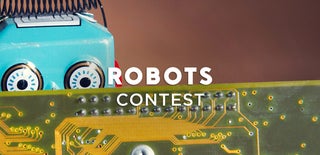Introduction: Voice Control Robotic Hand
I have created a robotic arm that will operate with your voice command.
The robot arm is controlled with natural connected speech input. The language input allows a user to interact with the robot in terms which are familiar to most people. The advantages of speech activated robots are hands-free and fast data input operations. The proposed robot is capable of understanding the meaning of natural language commands. After interpreting the voice commands a series of control data for performing a tasks are generated. Finally the robot actually performs the task. Artificial Intelligence techniques are used to make the robot understand voice commands and act in the desired mode. It is also possible to control the robot using the keyboard input mode. Robots are a package of systems which include mechanical, electrical, computing and automation fields of technology which can be used to perform various tasks in industrial and domestic use. And within creasing developments in this field robots can now be controlled with lesser direct human intervention to achieve a more natural interaction with machines. Away to accomplish such is to control a robot via voice commands. This allows the user to free up their hand sand work on other tasks. Some basic applications of robots utilizing voice recognition are to support people with disability, executing preset command set c. To process the voice commands a simple and efficient method is to use a smartphone. Smartphones are powerful devices capable of performing many functions similar to a computer. With their own independent operating system and internet connectivity they are increasingly being utilized in many applications. One of the major features that we shall make use of is the integrated Bluetooth. This will allow the phone to communicate with the robot.Several Operating Systems are used for smart phones but the most common one is the Android OS developed by Google Inc. Its flexibility and ease of use make it an ideal interface for robotic application.These android related systems are very efficient for developing applications throughout the world.Bluetooth technology exchanges data over a short range but is very proficient way of communicating between two devices such as micro controller and a smart phone. Data packages are sent and received through shortwave radio signals. It is essential for robots to take commands without any delay so we have used Bluetooth as the main communication method. In daily life such robots can be used for navigation and for control guidance to a certain position.The robot can either maintain preset linear speed or can be have variable speed on flat surfaces. The voice recognition is maintained with help of a micro controller; an Arduino (UNO). Two basic commands are used to steer the robot that are grape, release stop to guide the robot. To detect and catch any objects ultra-sonic module is implemented, programmed to catch the object if there is any object in its way, and inform the user to use another voice command.Ultra-sonic sensors use sound wave transmitters and receivers to record the echo time and use that to calculate the distance.MIT App Inventor 2 was used for developing an android application. This is a tool which uses block a programming technique so that even beginners can experience android app development. It was essential to develop an application to establish a wireless communication over a certain range via Bluetooth. In a nutshell we can conclude that voice controlled robots can certainly be a future market for many industrial and domestic purposes related to automating daily tasks.After several runs and tests our proposed method of Bluetooth communication worked efficiently with an acceptable time delay. The connections between the micro controller and Bluetooth worked quite well with a few errors in recognition of voice commands.We used both GSM and WIFI based internet connectivity for the application to recognize the commands and link it to Arduino. But for future modifications we can create an offline system for the application to recognize voice and send it back to micro controller. A few modifications in the android based application can result in a much more clarity of voice recognition.
Step 1: Components
1. Arduino UNO x2
https://www.amazon.in/Robotbanao-Atmega328p-Cable-...
2. Ultrasonic Sensor HC SR-04 x2
https://www.amazon.in/SPECTRACORE-Ultrasonic-Detec...
3. Servo motor Sg90 x4
https://www.amazon.in/Easy-Electronics-Servo-Motor...
4. String
5. REES52 Bluetooth Transceiver Module with TTL Outputs HC05
Step 2: Circuit
Step 3: Coding
Attachments
Step 4: Video

Participated in the
Robots Contest











